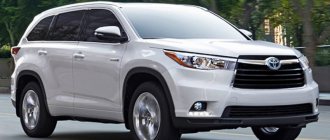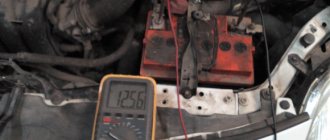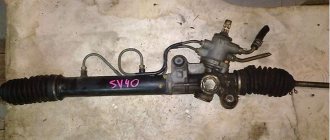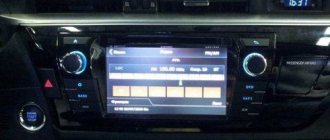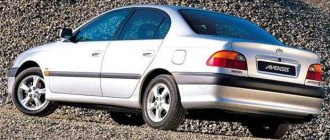5 / 5 ( 2 voices)
The fifth generation of RAV4 crossovers pleased car enthusiasts not only with an updated exterior, a cozy, spacious interior, excellent ergonomics, an active safety system, but also with a large selection of trim levels. For fans of TOP versions, Toyota offers an all-wheel drive car with a 2.5-liter gasoline engine and an 8-speed Direct Shift-8AT automatic transmission.
The 5th generation manufacturer is relying on a hybrid version of the car, where the electric motor is paired with a 2.5-liter power unit. This offer is relevant for European countries where they care about the environment; in addition, the hybrid version is the most powerful. In Russia today such cars are not available, but there is a possibility that they will appear, because the manufacturer expects that 80-90% of sales will be the hybrid version.
All-wheel drive Rav 4 1st generation
STD1 diagram
The Rav 4 10 uses permanent all-wheel drive STD I , which is a follower of the traditional Toyota FullTime 4WD . The distribution of moments is made in equal proportions between the two rows of wheels. This is achieved through a symmetrical, tapered center differential. The locking design is a multi-disc hydromechanical clutch.
At the same time, RAV4 10 was equipped with two types of gearboxes:
- A241H – with hydraulic control system;
- A540H - with full electronic control, while on models released after 1994 there is no control button.
To adjust the load distribution between the axles, there is a button C.DIFF AUTO , which is located on the center console. It is only missing on Toyota RAV4 equipped with A540H type gearboxes manufactured after 1994.
When the button is disabled, 4WD works with a free center differential. By turning on the button, the distribution between the drive wheels can be adjusted automatically. In this case, the range of changes in the maximum blocking coefficient is limited by two selector positions - L and R.
For normal 4WD operation, it is recommended to constantly use the automated load distribution between the axles. It is displayed only when the vehicle is towed or when driving with a spare tire.
Rav 4 20
The operating principle of 4WD Toyota RAV4 according to the STD I scheme provides the best reliability and efficiency.
- Guide for connecting radios on Toyota models
Second generation 4WD Rav 4 design
For the second generation Toyota Rav 4, a new type of 4WD was used. The all-wheel drive design is made according to the STD II . It involves blocking the center differential using a viscous coupling.
STD 2 circuit
This design was previously used on Toyota cars, where mechanics were installed as a transmission. Despite the significant simplification of the design compared to the first generation models, reliability remained at the same level. At the same time, there is a significant decrease in characteristics.
The design provides for the combination of the center and front differential between the wheels. At the same time, five satellites are mounted in the latter. In normal operation, the Torsen rear limited-slip differential is not loaded, but can be forced into gear.
Options and prices
Toyota RAV 4 with a 2.5-liter gasoline engine, all-wheel drive and an 8-speed automatic transmission is available on the Russian market in two trim levels: Comfort and Prestige Safety.
The Comfort package is equipped with LED optics, front and rear fog lights, light and rain sensors, electric and heated mirrors, factory tinting, a leather steering wheel and convenient adjustment of the steering column, fabric seat covers, electrically heated driver and front passenger seats, front and rear windows, front and side airbags, ABS, EBD, TCS, BAS systems, parking sensors, tire pressure sensor, dual-zone climate control, 8-inch monitor, audio system with 6 speakers, immobilizer and alarm. This version will cost the buyer almost 2 million 280 thousand rubles.
The Prestige Safety package costs 2 million 661 thousand rubles. This car has all the advantages of the Comfort version, and is also equipped with the following options: chrome door handles, a central panel with a 7-inch display, leather upholstery, an electric driver's seat with memory, heated rear seats, adaptive cruise control, blind monitoring zones, front and rear parking sensors, road sign recognition, automatic braking in the event of a risk of collision, a system that monitors the driver's condition, front and side cameras, a dimming rear view mirror. In this configuration, the emphasis is on traffic safety; numerous sensors and systems allow one to avoid many emergency situations, so when choosing this version, the buyer first pays for safety, and only then for additional comfort.
The 2021 RAV 4 has changed a lot compared to the previous generation. This car received not only a more modern and memorable exterior, but also many technical innovations. The TOP version with all-wheel drive, 2.5-liter gasoline engine and 8-speed automatic transmission is an excellent choice for lovers of comfort, dynamics, unique style and off-road driving. Of course, the crossover cannot be called a full-fledged SUV, but it can easily cope with the difficulties on the road that are often encountered in our country. The price of the car is quite high, but this does not reduce the number of people who want to buy it.
The interior is fully equipped.
Engine with combined injection A25A-FKS 2.5 liters
edit this post
All-wheel drive Rav 4 3rd, 4th and 5th generations
Toyota RAV4 3rd, 4th and 5th generations use an automatic all-wheel drive system. It consists of a multi-plate clutch that is controlled electronically. The electronics signal transmits torque to the rear wheels. Clutch blocking is affected by front wheel slip and the stabilization system. This improves vehicle control on slippery surfaces.
The Rav 4 3 has a function for forced locking of the clutch when driving in off-road conditions at a speed of no more than forty kilometers per hour. For this purpose, there is a Lock button located on the center console.
Connected all-wheel drive Toyota Scheme
For coordinated operation of 4WD, electric power steering and stabilization system on the Toyota RAV4, the Integrated Active Drive . If you get into a skid, the system adjusts the fuel supply, brakes the wheels individually and distributes torque to the front axle in the range from 55 to 100%. The force on the steering wheel is also reduced for the direction in which you need to turn to get out of a skid. Especially for Integrated Active Drive, Japanese designers installed a plug-in electromagnetic rear axle clutch on the Rav 4.
Scheme 4WD 3rd generation
- We study four-wheel drive (4WD) Rav 4 different generations
The Toyota RAV4 all-wheel drive transmission has the following operating principle. The cardan shaft is connected via a coupling to the input shaft of the rear axle gearbox. In normal mode, only the front axle is engaged, but if necessary, torque is redistributed to the second axle.
4th generation scheme
Depending on the specific configuration of the Toyota RAV4, the following all-wheel drive control options can be used:
Using the AUTO button, which allows you to use two modes - 2WD and AWD. In the first, only the front axle will work, with the button disabled. And when it is turned on, 4WD goes into automatic mode, accordingly, the additional axle will be put into operation as needed.
By means of the LOCK button, which ensures operation in automated mode or with the maximum degree of clutch blocking. The second mode is activated after pressing.
Some models are equipped exclusively with an AWD complex, which functions constantly.
4WD hybrid Toyota Rav 4
Japanese developers also use hybrid all-wheel drive for the Toyota Rav 4. Its operation is ensured by a gearbox and an electric motor. The following variations are used:
- classic three-shaft;
- compact two-shaft with a low-power electric motor.
In hybrid Toyotas with a plug-in rear axle, there is no rigid connection between the front and rear wheels.
Their operating principle is identical. The front axle operates in constant mode. In this case, there is no direct mechanical connection between the axes. Connection to the rear operation is carried out through a separate electric motor -generator and a two-stage gearbox.
Hybrid 4WD diagram
- Prevention of all-wheel drive Hyundai Creta - photos and videos
One of the types of all-wheel drive transmission Rav 4 5th generation
The new generation Toyota Rav 4 all-wheel drive is called Dynamic Torque Vectoring AWD . The work is based on torque vectoring, which allows you separately distribute the load on the rear wheels depending on road conditions. Also, the 4WD design allows the wheels to be completely disconnected from the incoming torque. This is possible thanks to the ratchet type coupling.
The features of the fifth-generation Toyota RAV4 all-wheel drive can theoretically improve cross-country ability and increase vehicle stabilization. Fuel consumption is also reduced due to the even distribution of torque across the wheels. When there is no load, the rear axle is automatically disabled.
Dynamic Torque Vectoring AWD
Technical specifications Toyota RAV4 2.0 4WD
So far, the majority of Toyotas on the roads are 3rd and 4th generations RAV 4 VD. The five-door station wagon weighs 1,510 tons, with a full tank - 1,560 tons. Its gross weight is 2,105/2,155 tons. The maximum trunk volume is 1,189 liters, in compact form - 580 liters. RAV4 4 VD accelerates to 100 km/h in 9.9-11 seconds and has a top speed of 190 km/h.
Dimensions of the RAV 4wd are 4.6 m in length, 1.855/1.685 m in width and height, respectively. The front/rear track span is 1,610/1,640 m with a ground clearance of 19.5 cm.
RAV4 Engine and Transmission Specifications:
- volume 1,987 cm3 - with a compression ratio of 13;
- by injection type - direct, turbocharged;
- in-line, 4-cylinder with 16 valves;
- cylinder piston stroke 97.6x80.5 mm;
- power - 175 hp. With. — at rpm 6.6 thousand;
- torque - max 4,300-5,200 rpm, Nm 208;
- transmission 4wd manual transmission6/variator.
Suspension and brakes RAV 4 on 4WD:
- front/rear MacPherson/multi-link suspension;
- wheels 5×114.3ET45d60.1;
- front/rear ventilated/disc brakes.
4wd fuel consumption per 100 km in the urban/suburban cycle is in the range of 6.8-7.7/5.3/5.4, respectively, in the combined cycle - 5.8-6.2. The fuel consumed by the RAV4 is AI95, the capacity of the filling tank is 55 liters.
In 2015-2017 The RAV 4wd model began to gain popularity and in 2018 became one of the most popular among Toyota owners.
Engine
The previous generation RAV 4 was equipped with 2.5 liter engines of the 2AR-FE modification. These power units developed power up to 180 hp. and had a torque of 233 N*m at a speed of 4100 rpm. The fifth generation crossovers are equipped with new A25A-FKS power units, which are superior in technical characteristics to the old internal combustion engines.
The 2.5-liter A25A-FKS combined injection engine has a power of 199 hp. and torque of 243 N*m at a speed of 5000 rpm. The cylinder block and cylinder head are made of aluminum. The compression ratio for this power unit is 13. The approximate engine life, according to the manufacturer, is 300 thousand km. Average fuel consumption in the combined cycle is 7.1 liters per 100 km.
The new engine is also equipped with an electric cooling system pump, an electrically heated thermostat, a new oil pump whose performance varies depending on the load, and an electric intake shaft drive. By bringing the oil and coolant channels closer together, the engine warms up faster in cold weather.
The power unit is still new, so it has not yet been possible to collect statistics on its shortcomings and typical malfunctions, but as for the dynamics, it makes a good impression. The only negative is that the combined injection system is demanding on fuel quality, so owners of cars with this engine need to carefully choose a gas station. Otherwise, expensive repairs await.
If we compare the acceleration dynamics of the RAV 4 version with a manual transmission and a car with an automatic transmission, the latter wins a little. The manual accelerates to hundreds in 10.2 seconds, and the automatic in 9.4 seconds. The maximum speed reaches 190 km/h.
How does four-wheel drive work?
All-wheel drive is an option, thanks to which all 4 wheels of the car are driven in permanent/temporary mode. As a result, the car is provided with excellent traction even with imperfect grip and does not suffer from skidding.
All-wheel drive layout:
| View | Principle of operation | Engine position | Car type |
| Classic | Torque is supplied through the driveshaft to the transfer unit, then to the front and rear axles | Longitudinal, in a single unit with gearbox and clutch | Trucks, buses, SUVs |
| Based on front wheel drive | Using a power take-off gearbox, torque is transmitted via the propeller shaft to the rear axle | Longitudinal, transverse | Cars |
| Rear engine | Rear-axle drive is combined with reverse gear, permanently engaged on the front axle, can be switched off | In the back of the car | Vans, vans, minibuses |
All-wheel drive wheels rotate at different speeds, and if one loses momentum, the speed of the other increases, while at the same time the torque decreases.
With a single motor, torque power is delivered to the axles in several ways. The choice depends on the chassis typology, design priorities, and rotation method. Today there are 4 methods:
- Connectable.
- Constant.
- Multi-mode.
- Permanent on demand.
The differential lock system is used for difficult-to-pass surfaces. In this case, the revolutions of all 4 wheels are equal, and the torque depends on the degree of adhesion to the road surface.
Review of Toyota RAV4 2.0 16v VVT-i (2008)
I finally got rid of this “device”, calmed down - now I can speak about it objectively, in my opinion. The car was purchased with the hope of ground clearance and some kind of (as it turned out!) full, albeit plug-in, drive. With the ground clearance, everything turned out to be more or less normal, I only hit it once with something in the suspension, probably with a lever, but this was while storming a very high curb. Actually, I myself am not a “car enthusiast”, but a “car driver”, i.e. I don’t particularly delve into the structure and nuances (it seems to me that this is normal - no one really studies either the structure of the metro, which they ride no less often, perhaps, than by car, or the structure of the house in which they live), I only evaluate consumer qualities with using various analyzers. So, almost all of my analyzers quietly suffered throughout the two years of owning the device. Of course, the reaction to something is purely individual, but in many ways my impressions coincided with those of other users, even very careful (so as not to offend such a brand and model that was respected until recently!) experts from various auto publications.
So, this car:
1. Very rigid, simply shaking like a cart on the slightest unevenness, rarely driving comfortably, imperceptibly for the body;
2. Very noisy, at a constant speed of 100 km or more - it feels almost like in the An-24, at lower or varying speeds it somehow doesn’t feel very pressing, but on the highway it’s a guard.
3. The interior creaks in different places, the creaks are transient, but constant, the roads, of course, on which she had to drive are not far from autobahns, but such a weakness was not expected anyway.
4. Legroom (height 186, more due to the latter) close to the minus - from time to time I had to straighten my left leg and push it somewhere under the dashboard past the clutch pedal in order to get rid of the unpleasant feeling of stiffness and cramped space.
5. By the way, about the clutch: uphill, when climbing curbs, wet slopes and in other situations when you need a careful grip - nothing will work (I’ve been driving only manuals for 19 years and have tried different options, the idea of the dubiousness of the “gasket” is asking leave), you are guaranteed a revving with a specific aroma, the engine is not small, so it immediately roars - or stalls, if you are careful.
6. Now about the engine, or rather its combination with the gearbox - this is the strangest phenomenon in my entire driving practice (about a dozen different cars)! The last (or rather the penultimate, the last one I just owned for about a month) car was a Seat Cordoba 1998. - with a 1.6 engine, only 75 hp. it just flew, it accelerated to 140 almost imperceptibly, it drove 170 without overexertion, it was, of course, inferior on a straight line to different 2-liter ones, but both in sensations and in practical results - it always fully provided positive emotions and speedy delivery to final destinations (I love driving quickly, not aggressively, but at the highest possible speed), and Rav - even his wife noticed, who does not like speed and dynamic passages! — it just doesn’t go, especially uphill, especially with passengers, especially up to 3000 rpm! I never ceased to be amazed at this: how could it be possible to “prime” 152 hp (or are they not there?!) with such a box!
7. About the gearbox - the rear one engages with a crunch, you just need to slightly underpress the clutch to the floor (!), the lever strokes are quite large, for an almost million-dollar car (in terms of price) - disappointment.
Disappointment - that’s the overall result of the car’s assessment!
Of course, it also has positive qualities: ground clearance, as I already said, although not off-road, of course, but all-road, by apt definition, and the length of the interior (3-meter panels fit end to end, but still), climate, all sorts of heating and other options, but everything pales in the face of the disadvantages described above. For that kind of money - below average pleasure.
The difference between permanent and all-wheel drive
Permanent all-wheel drive is reliable and allows the vehicle to be used on any type of surface. Its disadvantages are structural complexity, difficult control settings, increased weight and high fuel consumption.
All-wheel drive is more reliable from a mechanical point of view, easy to operate, and provides high cross-country ability to the vehicle. But the car cannot be driven on asphalt.
If you choose a drive type for Toyota RAV 4 - full permanent or plug-in - you need to check and evaluate the operating conditions. If there is no need to frequently move on soil with such changing properties as icy asphalt, snow ruts, hard surfaces with mud areas, then a plug-in drive is suitable. Otherwise, you will have to either frequently switch the system manually or overload the transmission, which does not always suit the owner of a RAV 4wd.
All-wheel drive Toyota RAV4
RAF4 with the latest generation 4wd all-wheel drive system, which has received expanded capabilities for movement on different types of roads, behaves more stable at high speeds.
What is the difference between the drive on Toyota RAV 4 versions 3 and 4:
- On a Toyota RAV 4 generation 3 in all-wheel drive, the multi-disc clutch is constantly running in auto mode. System locking depends on slippage and stabilizer. Off-road at speeds up to 40 km/h, the clutch is locked with the Lock button.
- All-wheel drive on the 4th generation Toyota RAV 4 works as follows: a vectorizer has appeared that distributes torque to the rear wheels separately. The ratchet type clutch is located on the rear and front axles. In this regard, there was no need for a stabilization system.
Now the rear wheels of the RAV 4wd receive up to 30% more torque, saving fuel consumption. But this is not the limit of optimization for modern cars: there is a tendency to replace permanent drives with on-demand drives.
The basic assembly of the RAV 4wd is equipped with the Dynamic TorqueControl AWD system: the new DynamicTorque VectoringAWD option will be offered as a possible configuration.
Toyota Land Cruiser 200 is a car of Japanese origin. Produced as a civilian jeep. The controls are intuitive even for the average motorist. But with the inclusion of all-wheel drive, questions arise.
Review of Toyota RAV4 2l 6-speed. mechanics (2011 onwards, 30500 km)
Reviews of Toyota Reviews of Toyota RAV4 June 04, 2013
First, I would like to talk about what preceded the purchase. Before Ravchik, I had a diesel Passat B6 - a wonderful car. But one day, while traveling to my dacha on a forest road, I got very caught on some bumps, which entailed significant repairs. After that, I began to seriously think about a new car with high ground clearance. After reviewing and trying various European, Korean and Japanese cars, my choice settled on the Toyota RAV 4.
So, the car is a 3rd generation, restyling, produced in 2011, the price at that time was $37,000. Engine 2 l, power 160 hp, 6-speed manual transmission, mileage 30,500 km. A feature of the restyled model is the installation of more aggressive headlights, a new more powerful gasoline engine and some changes in the interior (for example: a new steering wheel).
The car's equipment is basic, however, it already includes power accessories (mirrors and windows), climate and cruise control, standard music with mp3 playback and steering wheel controls, steering wheel adjustment, electronic security systems (ABS, ABD, VSC) and other options . Additionally, I installed original parking sensors front and rear, bought a set of Kumho 225/65 R17 winter tires, floor mats and a video recorder. The total cost of everything was almost 13,000 UAH or 60,000 rubles. Gasoline engine, 2 liter capacity, with variable valve timing. 6-speed manual transmission. I didn’t specifically consider the option with an automatic rifle. Still, for a car weighing 1.7 tons, the engine is rather weak, so it can only drive more or less actively with a manual transmission. Although for normal use the 160-horsepower engine is enough both in the city and on the highway. At the same time, the average consumption in the city is 9.5-10 liters, on the highway 7.5 liters at a speed of 100 km/h. In winter, 1 liter more. The engine is omnivorous - you can use 92 or 95, but I only use 95.
On the road, the car behaves very predictably, confidently holding its direction even in the conditions of the Crimean serpentines. When cornering, roll is slightly noticeable, which is natural for an SUV. Steering wheel with variable force and good information content. According to the passport, acceleration to 100 km/h is 10.5 seconds, it feels about the same, although of course I would like more. You feel confident in city traffic, although you won’t take part in races.
The car's suspension is independent. The classic MacPherson strut is installed at the front, and double wishbones with anti-roll bar at the rear. The suspension is good for an SUV, moderately stiff, but providing a sufficient level of comfort. During operation there were no special complaints or comments about the chassis.
Under normal conditions, the car is front-wheel drive. The electronics engage the rear wheels only when the front wheels slip. This is done very unnoticed by the driver. That's why I don't bother too much with it. It is possible to forcefully lock the center differential, but at speeds above 40 km/h the locking is automatically disabled and the car becomes single-wheel drive.
The car's interior is designed in a typical Asian style, so to speak, it's not for everyone. I like it, especially the two-tier front panel. As practice has shown, this is very convenient. The build quality is excellent. All buttons, levers, switches turn on smoothly, with pleasant effort. Nothing wobbles or rattles, and there is confidence that it will remain like this for a very long time. To be fair, I will say that the interior is generally modest, and the quality of materials is average, very far from its analogues from the German “Big Three”. Plastic and fabric are cheap, although more expensive cars have similar features. There is nothing to be done, the global trend is towards saving on everything!
The ergonomics of the driver are excellent. Everything is in its place, very convenient, you don’t need to reach anywhere. During operation, you realize that when this car was created, they were thinking about me! The only thing I don’t like is the gearbox lever sticking out alone from the tunnel. In my opinion, it could be decorated somehow, for example with aluminum edging. But this is nitpicking.
The seats are comfortable, with plenty of support, although not a BMW. I'm glad there is no tunnel in the back; a flat floor for rear passengers is a big plus. The 410-liter trunk is easily accessible, and if you fold out the rear row seats, the car can be loaded to capacity. You can even sleep if you wish.
When driving at high speeds, acoustic comfort is average. Particularly annoying is the noise from under the arches and the hum created by the standard Bridgestone 225/65 R17 wheels, which are simply disgusting from the factory. I still can’t buy normal ones. However, the suspension handles potholes and unevenness well. I've heard a lot about the RAV4 being a stool. I don’t know, overall I’m happy with everything. And if the road is normal, then the comfort is very good.
Operating costs. There were no breakdowns during the time I owned the car. The main costs are associated with the above-mentioned acquisitions and maintenance. MOT 1 and MOT 2 were completed at an official dealer at 15,000 and 30,000 km.
The car is generally good. If you are in search of a good SUV and are ready to put up with poor sound insulation, average materials and a modest simplicity of the interior, then buy it and you will not regret it. After all, the feeling of confidence behind the wheel that this car gives is worth a lot, and it will cover all the shortcomings.
TO 1:
Engine oil 5W30 355 UAH for 4.5 liters (1,700 rubles); Air filter 192 UAH (960 rubles); Cabin filter 224 UAH (1120 rubles); Oil filter 115 UAH (575 rubles); Work 800 UAH (4000 rubles). Total: 1686 UAH (8430 rubles)
TO 2:
Engine oil 5W30 355 UAH for 4.5 liters (1,700 rubles); Air filter 192 UAH (960 rubles); Cabin filter 224 UAH (1120 rubles); Oil filter 115 UAH (575 rubles); Brake fluid 184 UAH (920 rubles); Gear oil 80W90 180 UAH for 2 liters (900 rubles); Work, full diagnostics and wheel alignment 1320 UAH (600 rubles).
Total: 2570 UAH (12850 rubles).
Advantages of the car
I would like to note right away that the listing of the pros and cons of the car is very subjective, since this is my personal opinion. The main advantages of the ravchik are the following:
• High clearance and short wheelbase. This, combined with small overhangs, significantly increases the geometric cross-country ability of the vehicle. • Reliability: there were no breakdowns over 30,500 km. • Relatively low fuel consumption. • High build quality of the car. • Spacious trunk. • Good ergonomics. • Full-size spare wheel on a cast wheel. • The presence of a light sensor (a very useful thing) High liquidity in the used car market.
Disadvantages of the car
• Average level of acoustic comfort. • Average quality of materials. • An unclear algorithm for the operation of the rain sensor. • A “cricket” appeared in one place in the cabin. I can’t determine where exactly. • Average sound quality of stock music. • “Oak” standard wheels, which add additional rigidity while driving and constantly create background noise.
Vladimir
Reviews
Reviews and tests
Comments
+2 Vyacheslav 09.18.2013 18:29 I have a 2012 RAV4.
Well, first of all: the air filter on neither TO-1 nor TO-2 is changed. Secondly: the service interval is 10,000 km. Comment | Reply with quote | Quote | Complain
Update list of comments
Add a comment
How to properly turn on the all-wheel drive system of Toyota Land Cruiser 200
To enable all-wheel drive on the Land Cruiser 200, you need to find a control switch in the car. It looks like a round switch. It is located on the right side of the steering wheel, at the bottom of the control system. It is this switch that turns the drive of the Toyota Land Cruiser on and off.
Block 4 HP in the Toyota Land Cruiser 200 has only two operating modes and is switched by turning the arrow to one of two positions. 1 position is called H4 and the other L4. Each of them has personal aspects:
- H4 is called the high speed phase. It is turned on when driving in the city or on a flat dirt road, without obvious holes, bumps, or potholes.
- L4 is the low speed phase. It is better to turn it on when driving up a hill, descending a slope with a large angle, driving in mud, or on uneven roads. That is, it is used only in unfavorable conditions.
How to switch a Land Cruiser from position H4 to L4:
- Stop the movement of the car. Shifting without stopping is dangerous.
- On the gearbox, move the lever to neutral position.
- Turn the switch clockwise all the way to the right. You can't leave the arrow in the middle.
- Wait for the indicator to turn on, indicating that the drive gear is in a lower gear.
When switching vice versa from position L4 to H4, the same procedure is performed, but the switch must be turned completely counterclockwise, to the left.

